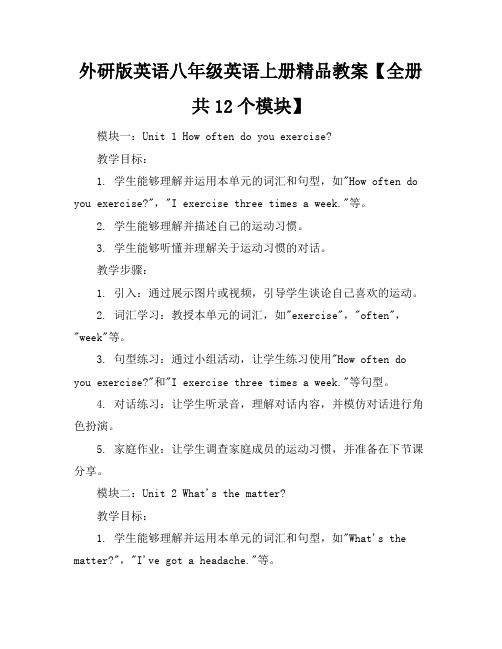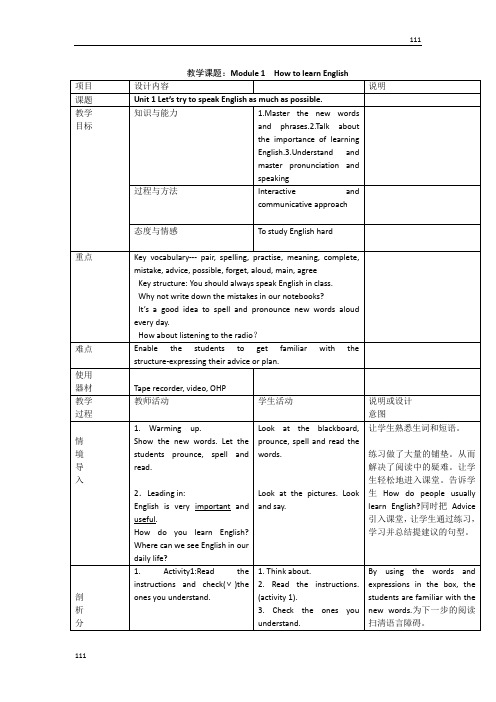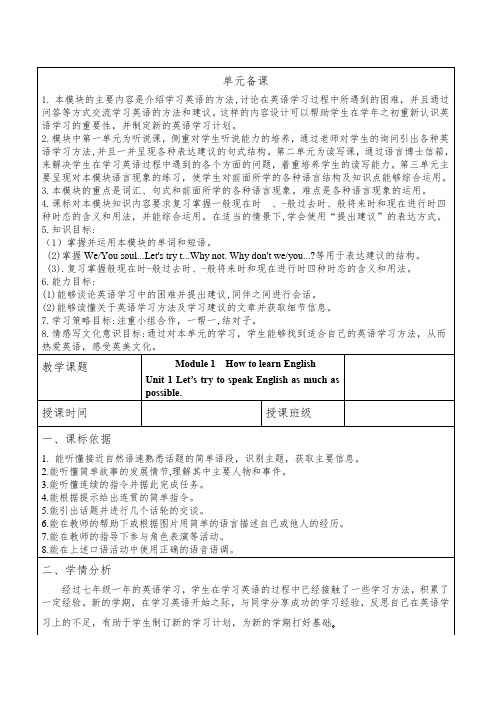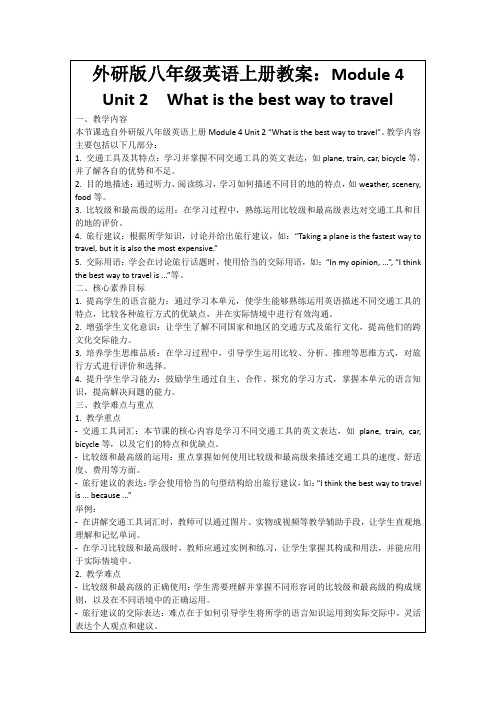最新外研版英语八年级上册全册教案
精选外研版八年级上册英语教案范文

精选外研版八年级上册英语教案范文精选外研版八年级上册英语教案范文〔一〕Section B 1a-2e教学目的一、知识与技能1. 掌握新单词和短语。
2. 在不同的情境中正确、纯熟地使用表示委婉恳求的句型。
3. 培养听、说、读、写四项根本技能。
二、过程与方法观看,感受,模拟,理论。
三、情感态度与价值观认识到不仅在家庭中,在生活中的其他情况我们也要积极参加,勇于理论。
教学重点在不同的情境中正确、纯熟地使用表示委婉恳求的句型。
教学难点培养听、说、读、写四项根本技能。
教法导航创设情境,理论演练。
学法导航通过听说读写,独立考虑,小组合作完成学习任务,进步各项才能。
教学准备图片,多媒体。
教学过程Step 1 GreetingsGreet the students as usual.Step 2 PreparationT:When I was a teenager,my parents often asked me to clean my room. Sometimes they asked me to buy some things. Now I often ask my daughter to take out the trash. What chores do your parents usually ask you to do?S1:My mother usually asks me to buy some food.S2:My mother often asks me to make my bed.S3:My father always asks me to clean my bike.S4:They ask me to clean my bedroom.T: Do you ask your parents to do anything? What do you ask them to do?S1:I ask my mother to make bed for me.S2:I ask my father to buy some books for me....Step 3 PracticeT:Look at the items in 1a,Section B. What can teenagers ask their parents to do? Whatdo parents ask their teenagers to do? Write “parents” or “teenagers” next to each phrase.Ask students to go through the phrases first. Give some explanations about the key words.teenager:someone who is between 13 and 19 years oldsnack:something eaten between mealsborrow:borrow sth from sbinvite:invite sb to sth 〔a wedding, party,meal, etc.〕; invite sb to do sthThen check their answers.Step 4 Pair workLet students use the phrases in activity 1a to make conversations between parents and teenagers. First,get a pair of students to read the sleconversations. Then students make their own conversations.Step 5 Listening1c, T:Now listen to the conversation between Sandy and her mom. Please check each item in activity1a they talk about. Put a check mark in front of each phrase you hear.Play the recording,students only listen.Play the recording a second time. Students listen and check the items.Check the answers with the whole class.Play the recording a third time. Ask students to write down the things the three people are going to do. Pause the tape where necessary. Then check the answers.Step 6 Pair work1e T:Suppose you are having a party. Make a listof things you need to do. Some things are already given. Write more things you need to do. Get students work in pairs and add more things to the list. For exle:buy some CDs,decorate the walls,make somegifts ...T: Now make conversations and ask your partner to do some of the things for you. Then ask some pairs to demonstrate their conversations.Step 7 DiscussionSay:Doing chores has advantages and disadvantages. What’s your opinion? Ask some students to reporttheir opinion. Then say:Suppose you are Ms. Miller or Mr. Smith,after reading the two letters,work in groups and discuss the advantages and disadvantages of doing chores. After a few minutes,ask some groups to report their opinions.Step 8 ReadingSay:Read the letters again and try to find outthe phrases in 2d. Ask some students totranslate the phrases first and then ask them to work in pairs to write one sentence with each phrase from the letters. Then ask some students to report their sentences.Step 9 Homework1. Finish the chart in 2c according to Ms. Miller and Mr. Smith.2. Discuss the questions in 2e with a partner.精选外研版八年级上册英语教案范文〔二〕 Module 8 Around townUnit1 How do I get to the Forbidden City?〔1-4〕教学设计外研版八年级〔上〕一、教材分析^p :本模块以出行旅游为话题,通过大量的语言材料集中展示了问路、指路、对某一区域进展描绘的语言表达方式。
外研版英语八年级英语上册精品教案【全册共12个模块】

外研版英语八年级英语上册精品教案【全册共12个模块】模块一:Unit 1 How often do you exercise?教学目标:1. 学生能够理解并运用本单元的词汇和句型,如"How often do you exercise?","I exercise three times a week."等。
2. 学生能够理解并描述自己的运动习惯。
3. 学生能够听懂并理解关于运动习惯的对话。
教学步骤:1. 引入:通过展示图片或视频,引导学生谈论自己喜欢的运动。
2. 词汇学习:教授本单元的词汇,如"exercise","often","week"等。
3. 句型练习:通过小组活动,让学生练习使用"How often do you exercise?"和"I exercise three times a week."等句型。
4. 对话练习:让学生听录音,理解对话内容,并模仿对话进行角色扮演。
5. 家庭作业:让学生调查家庭成员的运动习惯,并准备在下节课分享。
模块二:Unit 2 What's the matter?教学目标:1. 学生能够理解并运用本单元的词汇和句型,如"What's the matter?","I've got a headache."等。
2. 学生能够理解并描述自己的健康状况。
3. 学生能够听懂并理解关于健康问题的对话。
教学步骤:1. 引入:通过展示图片或视频,引导学生谈论健康问题。
2. 词汇学习:教授本单元的词汇,如"matter","headache","toothache"等。
3. 句型练习:通过小组活动,让学生练习使用"What's the matter?"和"I've got a headache."等句型。
外研版英语八年级上册教案 全册教案

1. Think about. 2. Read the instructions. (activity 1). 3. Check the ones you understand.
说明或设计 意图 让学生熟悉生词和短语。
练习做了大量的铺垫。从而 解决了阅读中的疑难。让学 生轻松地进入课堂。告诉学 生 How do people usually learn English?同时把 Advice 引入课堂,让学生通过练习, 学习并总结提建议的句型。
1. Read the words and phrases. 2. Listen and answer the questions. (Part 2). 1. Make sentences to practice the sentence structure. And then discuss what the sentence structure is like.要学生找出 Part3 中 提出建议的句型。 2. Listen to Part 3 and complete Part 4 then practice reading the dialogue in groups. Then several should be asked to read in public. At last ask some groups to act out part3. 1. Read the dialogue together with the tape recorder. Then read the sentences of Part 5, with the tape recorder. 2. Read the sentences to let the partner check if the sentences are pronounced in a correct way. Talk about problems in learning English and give advice. Students read, write and remember.
外研版八上英语教案

外研版八上英语教案【篇一:新外研版八年级英语上册1-12模块教案】 module 1 how to learn englishunit 1 let’s try to speak english as much as possible.第1、2课时【学习目标】1、(知识与技能):掌握下列重点单词的意思及用法:translate, correct, match number, advice,mistake, message, each, spelling,pronunciation, newspaper, excellent.掌握下列短语的意思及用法:give sb. some advice, write it/them down, speak english, in class, do some concerts, try (not) to do sth., each other, help sb. with sth.2、(过程与方法):通过本节的学习,培养学生的探究精神和创新意识,提高学生解决实际问题的能力。
3、(情感、态度与价值观)掌握学习英语的方法,提高学习英语的兴趣,懂得与人交流,注意语言的得体性。
【重点难点】1.重点句式:how about listening to the radio and reading a newspaper in english?try not to translate every word.you should always speak english in class.why don‘t you write down your mistakes?2.难点:提建议的常用表达方法。
【学法指导】课前在熟读单词与短文的基础上认真完成自主学习内容并能把重点单词短语熟记于心,完成探究内容,对未能解答的问题做上标记,课堂上,跟着老师的指导,完成听读训练,学习新的语法知识,并纠正自己在课前完成的任务。
Module 1 Unit 1教案2023-2024学年外研版八年级英语上册

三、学习目标Knowledge aims:Key vocabulary: pair, correct, spelling, word, practise, meaning,complete, sentence,dictionary,grammar, letter,look up, mistake, make a mistake, understand,advice, should,possible, write down, notebook, forget, aloud, radio, key,main, agree, agree with sb.Key structures: We/You should... Let's try to... Why not...?Why don't we/you...? Don't forget to.. It's a good idea to... How about...?Ability aims: 1. To understand the conversation on learning English2.To get information on how to learn English in reading and listening3.To learn different ways of giving advice and practise using them in real situationsMoral aims: Be proper when we communicate with others, try to care about other’s feelings in aconversation.四、教学重点、难点1.能在语境下理解、辨认并运用单词correct, practice, match, forget 等。
2024-2025学年外研版初中英语八年级(上)教案Module5Unit1

Module 5Lao She TeahouseUnit 1I wanted to see the Beijing Opera.设计说明教学反思从谈论对京剧的了解和喜欢程度引入新课。
通过对话的学习和演练,提升学生的朗读能力。
通过听力训练,提升学生在交谈中捕捉细节信息的能力。
学习新单词、短语和句型,学习新语言点,增加学生的语言积累。
初步学习动词不定式作宾语和双宾语的用法。
练习重音,提升学生在英语表达中的规范性和美感度。
通过对应练习,巩固学生对单词、短语、句型和语法的掌握,提升运用能力。
教学目标通过本单元的教学,让学生达成以下目标:1.知识目标掌握本单元新单词及短语:actress,teahouse,offer,end,in the end,no idea。
2.能力目标(1)能听懂关于谈论京剧的对话。
(2)学习使用动词不定式作宾语和双宾语的用法。
3.情感目标通过听说训练,更多地了解中国的京剧艺术,增强文化自信。
重点难点重点:对话朗读,动词不定式作宾语的用法和双宾语的用法难点:动词不定式作宾语的用法和双宾语的用法,句子中单词的重读教学准备PPT课件,有关京剧的图片,活动2、3、5的录音授课时数2课时教学过程Step 1Warming up1. Play the recording of the Beijing Opera to the class.2. Ask the students how much they know about the Beijing Opera and if theylike it.T: Do you know the Beijing Opera?Ss: …T: Do you like it?Ss: …T: Can you sing the Beijing Opera?Ss: …Step 2PresentationWork in pairs. Look at the pictures and talk about them. Use the words in the box to help you. (Activity 1 on Page 34)1. Ask the students to look at the pictures.2. Tell them to read through the words and make sure they know the meaningactress dance music play sing teahouse theatre traditional3. Ask them to describe the pictures in pairs.4. Encourage some pairs to present their conversations.Step 3Listening1. Let the students listen and underline the correct words or expressions. (Activity 2 on Page 34)(1) Ask the students to read the three sentences.(2) Play the recording and ask the students to choose the correct answers.(3) Have the students check answers with their partners.(4) Check answers and read full sentences with the students.Answers: 1 wants to see 2 doesn’t know 3 difficult(5) Play the recording again. Show the tapescript if necessary.Step 4Listening and reading1. Introduce the playwright Lao She and his play Teahouse to the class.2. Play the recording and ask the students to check the true sentences. (Activity3 on P35)(1) Read through the sentences and try to understand them.(2) Listen to the recording. Then check the true sentences.(3) Elicit the answers from the class.Answers: 3√4√5√3. Listen again and try to get answers to the question.1. Who went to Lao She Teahouse last night?2. Did Betty like the Beijing Opera?3. How long did they stay there in the end?4. Does Lingling often go to see the Beijing Opera?5. What is Lao She famous for?(1) Ask the students to read through the sentences and try to understand them.(2) Listen to the recording and try to get the answers. Allow some students toread the conversation if they still can’t get the answers after listening.(3) Elicit answers in full sentences for the class.Answers:1 Lingling and Betty.2 Yes, she did.3 They stayed there for three hours.4 No, she doesn’t.5 He is famous for his play Teahouse.4. Read the conversation again and find out the following phrases. Try to5. Listen to the conversation and read it.(1) Ask the students to listen to the recording and then try to read the conversation on their own.(2) Ask or encourage some students to read the conversation. Correct their mistakes.(3) Ask some students to practice the conversation in different roles.Step 5PracticeComplete the passage with the correct form of the words in the box. (Activity 4 on Page 35)(1) Read through the words in the box.complete it with the correct form of the words in the box on their own.(3) Check answers in groups.(4) Elicit answers from the class.Answers:(1) offered (2) difficult(3) actresses (4) end (5) mainStep 6Language points1. You know,I wanted to see the Beijing Opera,so Lingling offered to take me there. 你知道,我想看京剧,因此玲玲主动提出带我去那儿。
新外研版八年级上册英语全教案

新外研版八年级上册英语全教案一、教学目标1、帮助学生掌握新外研版八年级上册英语课程的基础知识,包括词汇、语法、阅读、写作等方面。
2、提高学生英语听、说、读、写四项技能,培养他们的英语综合应用能力。
3、激发学生对英语学习的兴趣和热情,培养他们的自主学习能力。
4、帮助学生了解中西方文化差异,拓展国际视野。
二、教学内容及重点难点本册教材共分为10个单元,每个单元都有一个主题,涵盖了日常生活的各个方面,如学校生活、家庭生活、环境保护、健康生活等。
每个单元都包括听说读写四个部分,以及语言知识、语法、词汇、文化背景等知识点。
重点:掌握每个单元的重点词汇和语法结构,提高阅读理解和写作能力。
难点:正确使用目标语言进行口头和书面表达,熟悉各种文体的写作技巧,如记叙文、说明文、议论文等。
三、教学方法及教学资源1、教学方法:采用情境教学、任务型教学、合作学习等多种教学方法,以学生为中心,激发学生的学习兴趣和主动性。
2、教学资源:利用多媒体教学设备、网络资源、教学软件等多样化教学资源,丰富课堂教学内容,提高教学效果。
四、教学过程设计1、导入新课:通过提问、复习等方式导入新课,引导学生进入学习状态。
2、呈现新知:通过图片、视频等方式呈现新知识,帮助学生理解课文内容。
3、实践活动:通过小组讨论、角色扮演等方式进行实践活动,提高学生的口语表达和写作能力。
4、课堂小结:通过总结重点难点、布置作业等方式进行课堂小结,帮助学生巩固所学知识。
五、评价与反馈1、评价方式:采用形成性评价和终结性评价相结合的方式,学生的学习过程和学习成果。
2、反馈方式:及时给予学生反馈和指导,帮助学生发现自己的问题和不足,提高学习效果。
六、作业布置与课外拓展1、作业布置:根据教学内容和学生的学习情况,布置适量的作业,包括书面作业和口头作业。
2、课外拓展:鼓励学生进行课外拓展学习,如阅读英语报刊杂志、听英语歌曲等,提高他们的自主学习能力。
外研版八年级上册英语全册课件是为了配合外研版八年级上册英语教材而制作的。
外研版八年级英语上册教案:Module4Unit2Whatisthebestwaytotravel

(三)实践活动(用时10分钟)
1.分组讨论:学生们将分成若干小组,每组讨论一个与旅行方式相关的实际问题。
2.实验操作:为了加深理解,我们将进行一个模拟旅行规划的实验操作。通过操作,学生可以直观地感受到不同交通工具的影响。
五、教学反思
在今天的教学中,我发现学生们对于不同旅行方式的特点和比较级、最高级的运用表现出较高的兴趣。他们在分组讨论和实验操作环节积极参与,这让我感到很欣慰。然而,我也注意到在实践活动中,部分学生对于如何给出合理的旅行建议还存在一定的困难。这让我思考,如何在今后的教学中更好地引导他们掌握这一知识点。
3.成果分享:每个小组将选择一名代表来分享他们的讨论成果,这些成果将记录在黑板上或投影仪上。
(五)总结回顾(用时5分钟)
今天的学习,我们了解了不同交通工具的优缺点,学习了如何使用比较级和最高级来评价旅行方式,并通过实践活动和小组讨论加深了对旅行选择的理解。我希望大家能够掌握这些知识点,并在实际旅行中灵活运用。如果有任何疑问,请随时向我提问。
此外,我在教学过程中也注意到了一些学生在听力方面存在困难,尤其是在理解不同交通工具的英文表达时。针对这一问题,我打算在课后找一些相关的听力材料,让学生进行额外的练习,以提高他们的听力水平。
1.加强比较级和最高级的语法练习,确保学生能够熟练运用。
2.提高学生的语言组织能力,让他们更自信地用英语表达自己的观点。
举例:
-在讲解交通工具词汇时,教师可以通过图片、实物或视频等教学辅助手段,让学生直观地理解和记忆单词。
-在学习比较级和最高级时,教师应通过实例和练习,让学生掌握其构成和用法,并能应用于实际情境中。
- 1、下载文档前请自行甄别文档内容的完整性,平台不提供额外的编辑、内容补充、找答案等附加服务。
- 2、"仅部分预览"的文档,不可在线预览部分如存在完整性等问题,可反馈申请退款(可完整预览的文档不适用该条件!)。
- 3、如文档侵犯您的权益,请联系客服反馈,我们会尽快为您处理(人工客服工作时间:9:00-18:30)。
Module 1 How to learn EnglishUnit 1 Let’s try to speak English as much as possible.一、学习目标:A.单词和短语:pair, correct, spelling, word, practice, match, meaning, complete, sentence, dictionary, grammar, letter, look up, mistake, make a mistake, understand-understood, advice, should, possible, write down, notebook, forget-forgot, pronounce, aloud, radio, pronunciation, key, main, excellent, agree, agree with sb., vocabulary, ask for, improve, basic, time, advise, shy, conversation, quickly, natural, suggest, placeB.交际用语:1. Ready?2. That’s a good idea.3. What else?4. Thanks a lot!5. Excellent!6. We should always speak English in class.7. Let’s try to speak English as much as possible.8. Why not write down the mistakes in our notebooks?9. It’s a good idea to s pell and pronounce new words aloud.10. How about listening to the radio?11. It’s better not to translate.12. It’s a good idea to check new words every day.二. 教学目标1. Function: Giving suggestions (English study)2. Structure: Giving advice: 1) We/You sh ould…2) Let’s try to…3) Why not…?4) It’s a good idea to…5) How about…?6) Why don’t we/you…?7) It’s better not to…3. Skills: 1) Listening and understanding familiar topics (English study).2) Talking about problems in English study and giving advice, conductingconversations in several turns.3) Reading and finding specific information about English study.4) Drafting a letter asking for advice about English study, revising throughpair discussion..4. Around the world: English online5. Task: Writing your English study plan.三、重点及难点:Giving advice: 1) We/You should…2) Let’s try to…3) Why not…? 4) It’s a good idea to…5) How about…? 6) Why don’t we/you…? 7) It’s better not to…四、教学设计:Unit 1 Let’s try to speak English as much as possible.ⅠTeaching modelListening and speakingⅡTeaching methodPWP approachⅢTeaching aims1. To understand conversations involving advice on learning English.2. To get information about how to learn English from the conversation.3. To understand the way of giving advice.4. To practise giving advice on English learning.ⅣTeaching Objectives1. Key vocabulary: pair, correct, spelling, word, practice, match, meaning, complete,sentence, dictionary, grammar, letter, look up, mistake, make amistake, understand-understood, advice, should, possible, writedown, notebook, forget-forgot, pronounce, aloud, radio, key, main,excellent, agree, agree with sb., vocabulary2. Key structures: 1) We/You should…2) Let’s try to…3) Why not…? 4) It’s a good idea to…5) How about…? 6) Why don’t we/you…? 7) It’s better not to…ⅤTeaching aidsTape recorder, OHP , videoⅥTeaching StepsStep 1 Warming up1. Show some pictures of school things. Say how to learn English well.2. Read the words after the teacher.3. Introduce the new words.4. Learn the new words.Step 2 Read and check.1. Read the instructions in Activity 1and check(√) the ones you understand.1) Work in pairs. Ask and answer the questions.2) Correct the spelling.3) Listen and check the words you hear.4) Practise saying the words.5) Match the words with the meaning.6) Complete the sentences with the words in the box.3. Ask the students to check their answer with a partner.4. Call back the answer from the whole class and check the answer.Step 3 Listen and repeat.1. Ask the students to read the word and expressions in Activity2.dictionary grammar letter look up make a mistake meaning understand 2. Read through the questions.1) Which word did Daming not understand?2) What mistake did Lingling make?3) How does Daming usually check the spelling of a word?4) Why is it difficult for Daming to check the spelling of cinema?3. Play the recording and ask the students to listen to the recording carefully.4. Listen and answer the questions. Use the words and expressions from the box.5. Play the recording again, then they can check their answer with a partner.6. Call back the answer from the whole class and check the answer.Step 4 Listen and read.1. Show some pictures, and ask the students to talk about them.2. Ask the students to read the conversation silently.3. Play the recording and ask the students to listen and read the conversation.4. Read the conversation.5. Act it out.6. Learn “Everyday English”Ready?That’s a good idea.What else?Thanks a lot!Excellent!7. Tell the students how to learn English well.1) We should always speak English in class.2) Let’s try to speak English as much as possible.3) Why not write down the mistakes in our notebooks?4) Don’t forget to write down the correct answers next to the mistakes.5) It’s a good idea to spell and pronounce new words aloud every day.6) How about listening to the radio?7) How about reading English stories?8) W hy don’t we try to find some English pen friends?Step 5 Writing.1. Read the conversation again.2. Ask the students to write notes about learning English.Listening : listen to the radioSpeaking : ___________________________________________________ Reading : ____________________________________________________ Writing: ____________________________________________________Learning new words: ___________________________________________3. Ask the students to check with a partner.4. Check the answers:Keys:Listening : listen to the radioSpeaking : speak English as much as possibleReading : read an English storiesWriting: write to pen friends, write down our mistakes in our notebooks, write down the correct answers next to the mistakesLearning new words: spell and pronounce new words aloud every dayStep 6 Underline the correct words and expressions.1. Ask the students to read through the passage in Activity 4.Here’s my (1) advice / notebook about learning English. Speak English (2) always / as much as possible in class, and listen to English (3) in the newspaper / on the radio. I (4) agree / forget it’s a good idea to look up n ew worlds in the ( 5) notebook / dictionary. You can find the (6) correct / excellent pronunciation and learn the meaning2. Underline the correct words and expressions.3. Check with a partner.4. Call back the answers from the whole class.Keys: 1. advice 2. as much as possible 3. on the radio 4. agree 5. dictionary 6. correct 5. Read the passage together.Step 7 Listen and repeat.1. Play the recording once without stopping.2. Play the recording again and ask the whole class to repeat.1) We should always speak English in class.2) Let’s try to speak English as much as possible.3) Why not write down the mistakes in our notebooks?4) It’s a good idea to spell and pronounce new words aloud.5) How about listening to the radio?3. Ask the students to listen and mark the intonation.4. Now listen again and repeat.Step 8 Work in pairs.1. Talk about problems and give advice.Problems AdviceI can’t… How / What about …?I don’t know… Why not / don’t you …?2. Read through the example with the class.—I can’t speak English well. What should I do?—Why don’t you try to talk to our classmates in English?3. Work in pairs.Step 9 Important and difficult points1 Why not write down our mistakes in our notebooks?何不在笔记本上把我们的错误记下来?Why not …? 用来表示提出某种建议,而不是询问为什么不做某事的原因,例如:Why not take a walk in the park ?何不在公园里散散步?我们还可以用下面的表达方式来提建议:Why don’t we drive to the country?我们何不开车去乡下?What / How about going to Europe for a holiday?去欧洲度假怎么样?Write down 或者put down 表示“记下,写下”。
